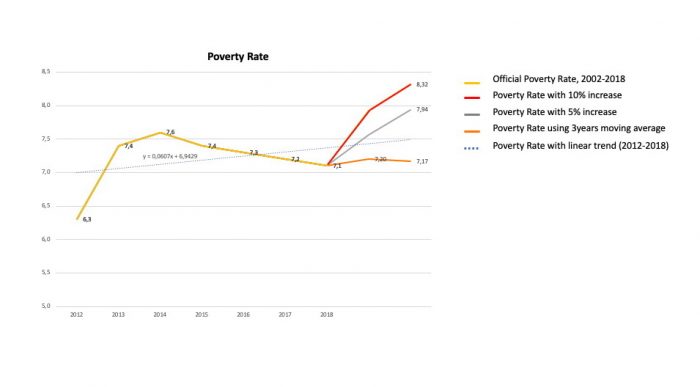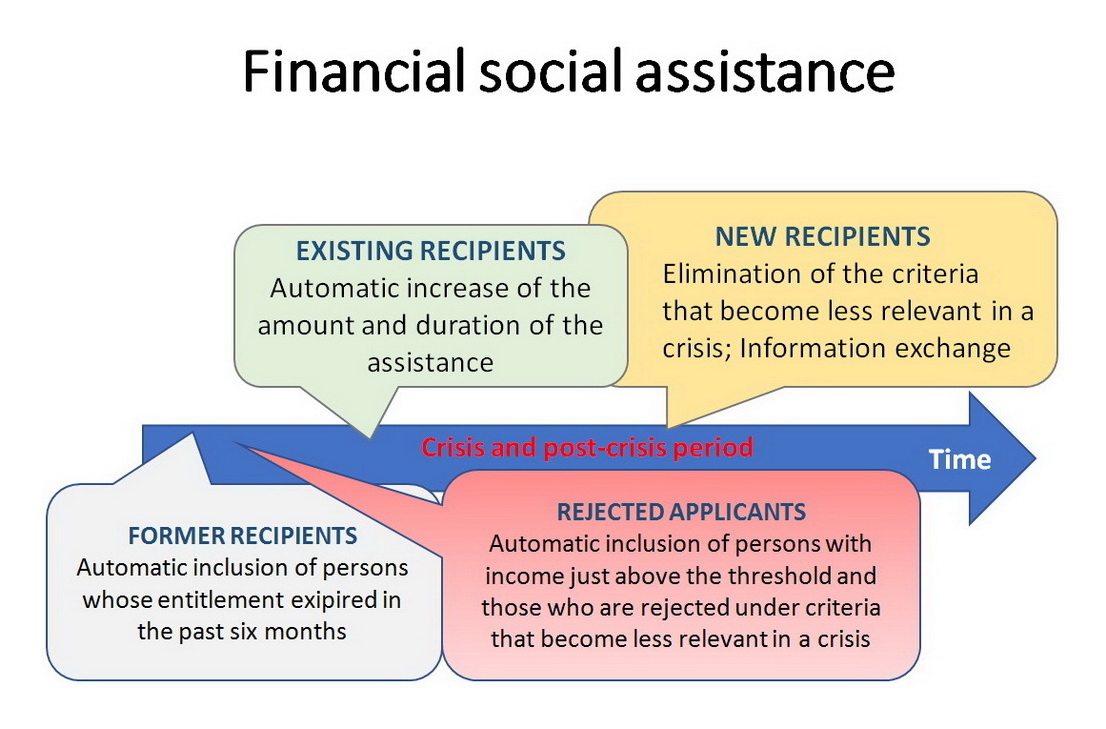The crisis on a global scale caused by the COVID-19 pandemic has brought many health care and socio-economic challenges and has raised questions about the approaches to be taken toward addressing the consequences. One of the issues is the impact of the pandemic on poverty in the crisis and post-crisis periods. International experts, in cooperation with the World Bank, have estimated that about 49 million people suffer from extreme poverty as a consequence of the COVID-19 pandemic and that this pandemic has triggered the first increase in global poverty after 1998 (when the Asian Financial Crisis hit).[1] Even under the assumption that a country’s economic growth impacts equally all its inhabitants, i.e. that the COVID-19 pandemic has no influence on the inequalities within a country, the projections show that we can expect the increase of poverty at the global level (from 8.2% in 2019 to 8.6% in 2020, i.e. from 632 to 635 million people living on less than $1.9 per day).[2]
According to international experts, the severity of the pandemic’s impact on the increase of poverty in a country depends primarily on two factors: 1) the impact of the pandemic on economic activity and 2) the number of people living close to the poverty line.[3] In addition to these, other points to be considered include the income distribution in the country, i.e. the question how the newly created value will be distributed among the country’s population.
In the Republic of Serbia, poverty especially affects households where the head of the household has a low level of education (incomplete primary school), or does not participate in the labour market (inactive) or is unemployed.[4] According to the data for 2018, there is considerable concentration of the population close to the poverty line. As a consequence, the increase of the poverty line (which in 2018 amounted to RSD 12,286 per month per consumption unit) by a mere 5% would push a further 70,000 people into the state of absolute poverty, while an increase of the poverty line by 10% would result in as many as 147,000 new poor.[5]
 Biljana Mladenović, Social Inclusion and Poverty Reduction Unit
Biljana Mladenović, Social Inclusion and Poverty Reduction Unit
Social transfers[6] significantly contribute to the decrease of the poverty rate, including in ordinary circumstances, i.e. in non-crisis periods. In 2018, social transfers effectively reduced the poverty rate by 28%, i.e. without social transfers, as much as 9.9% (instead of 7.1%) of the Serbian population would have been poor.[7] The financial social assistance, as one of the most important social transfers for the Serbian poor, is a significant resource for alleviating the impact of the COVID-19 pandemic on the most vulnerable population categories. Besides the exceptionally good targeting (almost 90% of the expenditure goes to the poorest among the poor[8]), the available administrative data on financial social assistance recipients, as well as on rejected applicants and the persons whose entitlement expired just before the outbreak of the epidemic, are a valuable resource that facilitates timely and accurate protection of society’s most vulnerable members. Furthermore, Article 110 of the Law on Social Protection provides for the possibility of awarding one-off cash assistance from the Budget of the Republic of Serbia, in situations of extraordinary threat to the lives of a large number of people. This legal provision is a valuable resource for the protection of the most vulnerable population, based on the available administrative data.
Biljana Mladenović, Social Inclusion and Poverty Reduction Unit[9]
The expansion of social security nets, both horizontally (by increasing the assistance amounts) and vertically (by increasing the coverage, i.e. by granting the entitlement to more people), was recognized as one of the key necessities in the crisis and post-crisis period by the speakers and participants of the online conference on “Poverty during the COVID-19 Pandemic and in the Post-Crisis Period in the Republic of Serbia”, organized by the Serbian Government’s Social Inclusion and Poverty Reduction Unit on 20 May 2020. It was also emphasized at the conference that the support measures targeting workers in many countries covered only the formal sector, while the inactive population and/or the informally employed (whose position was adverse even before the crisis) remained in a high-risk situation. The fact that the pandemic represents a health risk for all and a socio-economic risk for most people has led many states to implement targeted support measures for the disadvantaged population (thus ensuring that the support reaches the most vulnerable people, while maintaining a prudent attitude towards the public resources). However, the positive effects of this approach to the most vulnerable population categories remain questionable. In case of a new wave of the pandemic, as well as in the post-crisis period, it is crucially important to consider the support measures that will target the most vulnerable population groups in order to ensure a timely response to the pandemic’s impact on the increase of poverty globally and in the Republic of Serbia.
Social Inclusion and Poverty Reduction Unit of the Government of the Republic of Serbia
—————
[1] The impact of COVID-19 (Coronavirus) on global poverty: Why Sub-Saharan Africa might be the region hardest hit
[2] PovcalNet, the World Bank’s tool for estimating the global poverty rate, i.e. the share of the world’s population living on less than $1.90 per day.
[3] The impact of COVID-19 (Coronavirus) on global poverty: Why Sub-Saharan Africa might be the region hardest hit
[4] Assessment of Absolute Poverty in Serbia in 2018
[5] Projection based on the Statistical Office of the Republic of Serbia’s 2018 data on the decile distribution of consumption and income in the Republic of Serbia.
[6] The calculation of social transfers includes the following income components: (1) Revenues based on health insurance (reimbursements for sick leave etc.); (2) Maternity leave and childcare leave; (3) Social assistance, benefits and other income based on social welfare (financial social assistance, attendance allowance, birth grant etc.); (4) Income support for unemployed and temporarily unemployed persons; (5) Personal and family disability benefits and attendance allowance, benefits for civilians disabled in war and war veterans; (6) Income from alimony and child support; (7) Child allowance; (8) Pupil and student scholarships, allowances for the students of vocational schools, rewards etc.
[7] Assessment of Absolute Poverty in Serbia in 2018
[8] Third National Report on Social Inclusion and Poverty Reduction in the Republic of Serbia for the Period 2014–2017, Table 11, Annex 1
[9] Adapted based on illustrations in Serbia Strengthening Social Protection for Disaster Response, World bank 2019
(The text was originally published as the Introduction to the 61st Social Inclusion and Poverty Reduction Newsletter.)
 Government of the Republic of Serbia
Government of the Republic of Serbia

















 pdf [271 KB]
pdf [271 KB]
Leave a Comment